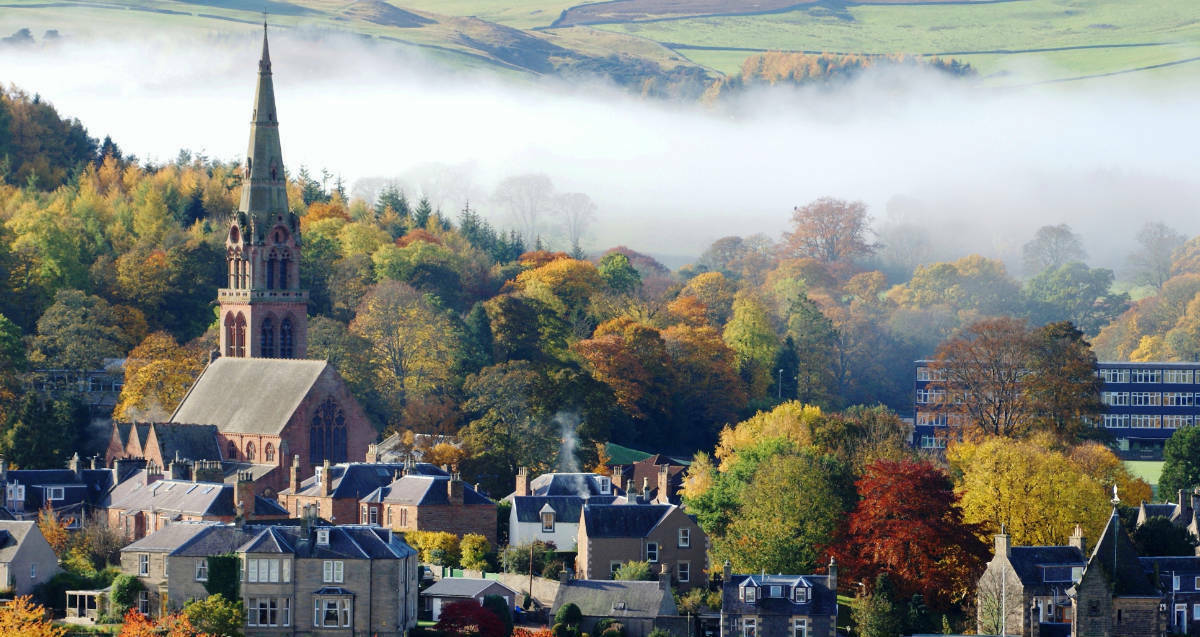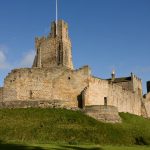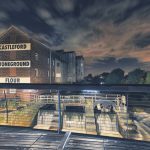
Galashiels The Borders town with the motto “Soor Plooms.”
If you haven’t heard of Galashiels yet, you are in for a treat. This is an interesting town in Scotland that you find on the road between Carlisle and Edinburgh. For a town with a population of around 12,500 people, it has seen some cracking memories over the years.
It is a traditional Scottish town that has buildings dating back to the Industrial period – so you already know it’s going to make a lovely day trip or holiday out. The Scottish Lowlands play home to the Southern Uplands, a popular camping and hiking destination known for tremendous beauty. And sheep. There is a lot of sheep. No haggis this far south though.
Let’s take an in-depth look at all Galashiels has to offer. We’ll start with the fascinating history and go from there.
The Early History of Galashiels
Galashiels sits on the River Gala, from whence it gets its name. The town sits near the confluence of the Gala and the larger River Tweed. It is on the edge of the River Tweed basin, a gorgeous section of the countryside filled with stories.
One of our favourites is an hour away and a little south. There, at the head of the Tweed, you will find a vast gully of land known as “The Devil’s Beef Tub.” This hollow in the land gave protection to the stolen cows stored below. The hollow was seen as the devil’s work. This dramatic landscape features a roadside monument to John Hunter, who was shot here after arrest for attending a forbidden church service nearby. Legend has it that he tried to escape by rolling down the hillside into the mists. If you like a view and a good tall tale, pay it a visit.
But back to Galashiels. The town is split into east and west due to the river. The eastern bank of Galashiels lies in Roxburgh, while the west is in Selkirkshire. The town features a nearby landmark that might give clues to its true age. The Catrail, or Pict’s Work Ditch, is a trench running through both counties.
The Catrail
The Catrail runs alongside Robert’s Linn, a burn that flows into the Slitrig Water. The trench is 18.5km long and nobody knows what caused it. Since it dates to the 4th and 5th centuries, it’s probable that either the Picts dug it to keep the Romans out, or the Romans dug it to keep the pits out. It seems like the kind of task the Roman army would undertake.
On the north-western side of town stands another ancient fortress. This one dates to the Iron Age. It was a hill fort, to begin with anyway. Later, the townsfolk built Torwoodlee Broch over the top of it. The Romans marched in and destroyed the Broch in 140.
We always like to bring up the clans that would go on to occupy these areas of Scotland even while the Romans threatened from the south. Torwoodlee is the home of the Pringle family and has been since 1501 when they became Lairds. Before that, the Pringles were at Flodden, they fought for the restoration of the Stuarts and against William of Orange. Nearby clans include the Kerrs, the Douglas clan, and the Scotts. Another interesting side note is that Castle Douglas has a second name: Castle Danger.
Let’s assume the clans spent the formative years fighting Romans, fighting each other, and raiding south of the border to steal English cattle for a few hundred years and move on to Medieval times.
Medieval Age Galashiels
In 1337, a group of English soldiers were reclining in a nearby clearing, eating plums off the trees. Wild plums are common in Scotland and the troops were enjoying the fresh fruit. The townsfolk spied them there and ambushed them. It was either a great victory or a terrible loss, depending on which side of the border you live on. The townsfolk remember the incident in a coat of arms. The coat features a fox trying to reach plums on a tree.
The motto reads “Soor Plooms.” Now… someone who hadn’t grown up in Scotland might not know that Soor Plooms are a type of hard-boiled candy here. They are bright green and sour, made to imitate the underripe wild plums. They taste a little like green gooseberries. Those from Galashiels will also be aware that Robert Coltart, of Coltart’s candy, lived in the area and would know that story. The sweets are made by Gibbs, not Coltart, but we bet the sweet is based off that same story.
The town erected Buckholm Tower in 1582. The site is in a hazardous condition now, although you can still visit. The town sits at the foot of Buckholm Hill. As you can imagine, it belonged to the Pringle family… but this one comes with a ghost story. The tale says that James Pringle, the Laird at the time, was a keen hunter and a wicked man. He treated his own wife and son so badly that they fled.
Covenanters
He hunted Covenanters on his lands – covenanters just like John Hunter, who was shot in the Devil’s Beef Tub. He did horrible things on behalf of the crown. One incident features Buckholm Tower. He was called out to disrupt a Covenanter meeting by the dragoons. When they arrived, all but two of the men had fled. The two were father and son. The father’s horse had thrown him. The son stayed with the father.
The dragoon captain asked the Laird – who wanted to kill them on sight – to keep them in his tower overnight until they could transport them south. The Laird agreed. After too much ale, the servants reported that the son was crying out for help for his injured father. The Laird went to the cell and beat them both so badly that they died. He hung their bodies from hooks on the walls when he was finished.
Later, the wife and mother of the two braved the castle to ask what had happened to her men. The Laird took her to the cell and showed her, so cruel a man was he. Legend doesn’t say if she made it out alive or not, but it does say that she laid a curse on him. Ever after, the Laird was plagued by dreams of being hunted, or of waking nightmares where hounds were chasing him. The tower held so many evil memories that locals believed it haunted. In fact, in the 1700s, the local reverend performed an exorcism on the castle.
The Burgh Of Galashiels
Galashiels received its Burgh status in 1599. Although originally intended as a village to house the workers at Melrose Abbey, to the south. Melrose Abbey is the historic resting place of the heart of King Robert the Bruce. In 1622, a new church opened in Galashiels, showing growth in the size of the parish.
Around the same time, Buckholm and Gala suffered attacks from the English. They raided many border towns and settlements. The following year, the Scots struck back by attacking England under the leadership of the Acting Regent the Earl of Arran. They beat back the English at Ancrum Moor near Jedburgh, but victory was only ever short lived. The two sides continued to fight until unification. They still fight now if you catch them in the wrong mood.
Let’s pause in all this fascinating history for something more light-hearted. The fun facts.
Fun Facts about Galashiels and the Scottish Borders
There are always little tidbits of history that we like to collect here and there. They are the fun facts, the useless trivia, the historic points that the history books would rather we forgot about. We do not forget. We record them here for posterity and entertainment purposes. Here are our favourite facts about Galashiels:
- We can’t go one step farther without mentioning that Sir Walter Scott grew up here. He lived in Ashiestiel and in Abbotsford in the early 1800s.
- The Reverend Henry Davidson performed the exorcism of the tower. He declared he had ‘cast out the de’il of Buckholm’. That doesn’t stop locals from avoiding the place at night. It’s said that James Pringle returns every year on the day of his death – alongside the pack of dogs that hunt him.
- The nearby village and abbey at Melrose were given charters by King David I, who died in 1153. Galashiels was an overspill town for those whose families lived or worked in the abbey.
- Galashiels stayed a small village up until the Industrial Era. After the Second World War, the population never recovered to what it had been before.
- Robert Burns, the Bard, wrote two songs about Galashiels: “Sae Fair Her Hair” and “Braw Lads”. He was from all the way through in Alloway, near Ayr, so it says a lot that he bothered to write about it.
- Robert Coltart, of Coltart’s Candy, is a bit famous up in the north. Thanks to an advertising campaign that featured the Scots lullaby ‘Ally Bally Bee,’ the sweet maker has immortalised himself. The jingle goes “Ally bally, ally bally bee, sitting on yer mammies knee, looking for a wee baw-bee, tae buy some Coltart’s candy.” There are many Scots who have fond memories of their grandparents singing this to them.
That’s enough fun facts about Galashiels and its interesting habits for now, but only because we are running out of space. This is an ancient Scots town with a lot going on, so let’s finish the history so we can get to the attractions.
Industrial Era Galashiels
During the Industrial Period, Galashiels suffered from the same poverty that most of Scotland did. Those who were too sick, old, young, or infirm, to take care of themselves ended up in the poorhouse. In 1859, Galashiels Combination poorhouse opened to the public. It combined the parishes of Bowden, Melrose, Selkirk, Yarrow, and Galashiels. Together, the towns had shy of 30,000 people. The building still stands but it is a care home for the elderly and hopefully, nobody makes them work.
From the late 1700s, circa 1771, feuds broke out in town over the division of space. Every landowner wanted factories, and everyone wanted a mill on the Gala Water. The water would turn the wheel and make the work easier, and Galashiels was a rising town in the textile industry back then. With so many sheep, it had a lot of wool to be fulled and dyed. It had flax to be woven and flour to grind. By the end of the 18th century, the banks were lined with houses and mills.
The Train Arrives
The railway route between Carlisle and Edinburgh was completed in 1849 and passed through Galashiels. The line connecting Edinburgh to Galashiels was renamed the Waverley Route in honour of Sir Walter Scott. The Waverley route closed in 1969. In 1867, the town erected the Galashiels Burgh Chambers to house the 1599 charter. To this day, a yearly parade marks the charter and the men of the town recite Burns’s poems. At the end of the Industrial period, the Paton Street Drill Hall started housing military personnel.
By the end of the Industrial Era, there were 21 mills in Galashiels. The old mill trail connects all of them around town and you can follow it. The town’s population was 600 people at the start of the industrial period. By the 1890s, there were 17,367 people living here. This slunk off after the mills began to close. Nowadays, the population is closer to 14,000 people than 17,000. One of the biggest mill owners in town was Lochcarron of Scotland, who moved to Selkirk in 2006.
Galashiels During the Wars
The people of Galashiels gave proportionately too much during the two world wars. 635 men’s names are carved into the war memorial in the Burgh Chambers. At a time when the town had a population no greater than 15,000 people, that was a huge loss. The disproportionate loss might be something to do with the local regiments. The King’s Own Scottish Borderers regiment drew heavily from the southeast of the country. Interesting fact: they hold a recruiting record for enlisting 800 men over 4 hours by beating a drum along the Royal Mile in Edinburgh when they first formed to protect the lowlands from the Highlander army in 1689.
Modern Galashiels
The town never quite recovered the population it had in the industrial era. After the mills closed there wasn’t much work, forcing many into the army. The town hosts the College of Textiles, which joined Heriot-Watt University in 1998.
In 2015 the railway route reopened and Galashiels became connected to the outside world again.
Modern-day Galashiels thrives on tourism born from a rich history and thoroughly Scottish culture. It’s a gorgeous town with plenty of staycation sites to see, and caravan and camping facilities throughout the surrounding countryside. It’s a great place to make memories in.
Famous People from Galashiels
Before we get to the attractions, we need to talk about famous people. We’re not expecting much this far to the north, but let’s take a look…
- Footballers Lewis Allan, John Collins, George Henderson, and Richard Tait.
- Cricketers Charis Scott and William Nichol.
- Ross Kelly, former GMTV presenter
- International Bowler Joyce Lindores lived here
- Ryan Mania, 2013 winner of the Grand National
- Artist Anne Redpath
OK, so not many of them are recent, but it’s still a fair amount of successful people for such a small area.
Best Things to See and Do in Galashiels
In this section of the article, we like to examine the best attractions in town. Here are the sights that you ought to see in Galashiels as voted for by locals and the Five Minutes Spare crew.
Historic sites and Landmarks
The most notable historic site in town is Abbotsford. This is the stately home that Sir Walter Scott bought in 1811. It describes itself as a museum for living, devoted to the life and times of the great novelist. The estate features beautiful gardens backed by the gorgeous rolling hills of the Tweed basin. It has turrets and tapestries and endless libraries. You can visit the house, the gardens, the estate lands, or the visitor centre while you are there. It’s beautiful and so well preserved. Take your camera.
Torwoodle Broch
There are two landmarks we have already talked about that lie near Galashiels. The first is the Torwoodlee Broch, which lies to the north west of town. It’s about two miles out and set into the hillside. You can still see the remains of the earthen work fort there. It’s a nice afternoon out in a spot with good views in nice weather. There is also the Catrail to go and visit, although it is just a large trench. Everyone loves a mystery though and nobody agrees on who built it or what for.
If you want a spooky day out, you can visit the ruins of Buckholm Tower which lies at the foot of Buckholm Hill. Make a day of it and have a hike to the cairn at the top if you like. Take a rock up with you and leave it on the pile, as is traditional. Stop by the ghostly tower on your way back and take a few photos. You can examine the shots later for ghosts. Be careful though, it’s in a bit of a hazardous condition. Don’t get too close.
Galleries and Museums
The Old Gala House is where the locals store their records. This beautiful old building houses 400+ years of Galashiels history for your perusal. They have two separate gallery spaces too, so you can pick up some local artwork or browse fine paintings.
Outdoor Attractions
There are so many historic sites around this part of Scotland that we are squeezing another one in here. Melrose Abbey, the resting place of Robert the Bruce’s heart, is a fascinating place to visit. Its dramatic towers and stunning cloisters still stand today. They have had masonry inspections in recent years so parts could be closed off when you go there. Nevertheless, there are gorgeous grounds to wander and beautiful gardens to see. The old building makes any photo stunning.
Take a trip to see the Cornmill Fountain, inside the Cornmill Square in town. If you look closely and ignore the balustrade, you can see carvings of the town’s coat of arms, boys riding dolphins, and other intricate pictures. It’s a free way to entertain yourself and learn about the local culture. You can also get your groceries in while you are there.
Sports and Recreation
There are two golf clubs, each with a wonderful clubhouse. Visit the Galashiels Golf Club or stop in at the Torwoodlee Golf Club to catch a few rounds.
The local Football Club are Gala Fairydean Rovers FC. They are fairly new kids on the block so to speak having been formed via a merger in 2013. However, their predecessors can be traced back to 1894.
On the other hand, the local Gala Rugby Club opened in 1875 and is still going strong in its original form.
Shopping and Retail
There are not many shops in Galashiels but you can find all you need near the town centre.
Other Notable Attractions
Even if you have seen all of the above, you won’t be short of new things to do in this end of the country. Here are some other points of interest to see in this area:
- Visit the historic town of Moffat for the day and make sure you try the toffee.
- Take the tour of the Tempest Brew Company.
- Join in the Galashiels Walking Festival out in the local community
- Take the kids to Mojo’s Soft Play for a laugh.
How to get to Galashiels?
This is the part of the article where we send you off with terrible directions and hope for the best.
By Road
Follow the A7 either north from Carlisle or south from Edinburgh.
By Rail
The Scottish Borders line connects Galashiels with Edinburgh. However, there is no direct rail link from England.
By Air
The nearest international airport is Edinburgh airport.
By Sea
Alas, you would need to sail up the Tweed.
Need More Entertainment?
If you still have time to spare and need some light reading, check out more of our travel guides. Otherwise, join us on Facebook and show your support.




